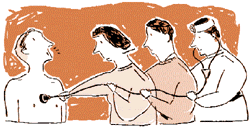HMO's "R" Us: A Prescription for the Future
Consumers have learned in the past few years to buy books over the Internet, computers over the phone and financial products at the supermarket. Coming soon: a new way to buy and sell health-care benefits.
 Imagine a world in which you can call an 800 telephone number or log onto the Internet, do a search of available health plans, compare their performances, mix and match service offerings, check the cost to you and your employer and then enroll and select a new primary care physician -- all within minutes and from your home. This would be a far cry from the current health-benefits distribution system, which is both anachronistic and paternalistic.
Imagine a world in which you can call an 800 telephone number or log onto the Internet, do a search of available health plans, compare their performances, mix and match service offerings, check the cost to you and your employer and then enroll and select a new primary care physician -- all within minutes and from your home. This would be a far cry from the current health-benefits distribution system, which is both anachronistic and paternalistic.
Health insurance is one of the most important services we can buy for our families, and yet our employers continue to play significant roles, often using manual and bureaucratic processes. It is our employers who:
- Select (and limit) the available plans, often offering just two or three.
- Determine the level of the health coverage.
- Filter the information we receive about quality, costs and other significant details of the plans.
- Intervene with plans when disputes over coverage or service arise.
Compare this with the customer-oriented and streamlined world of retirement benefits. There, the defined-contribution revolution has brought about sweeping changes over the last decade that have benefited employer and employee alike:
- Employees choose from a variety of investment options based on widely available performance data.
- Employees deal directly with the plan administrator.
- Employees can elect to contribute pre-tax dollars to expand the size of the benefit.
The popularity of this alternative approach to retirement benefits is evidenced by the steady growth of defined-contribution programs and the decline of defined-benefit programs. (See Exhibit I.)

Moving to a health-care model more closely resembling the retirement benefits world would provide employees with a revolutionary new control over their health-care coverage, and we believe there is an imminent shift in this direction in the market. However, one key ingredient is missing: a retail supermarket of health plans where employees can more fiexibly spend their defined-contribution health-benefit dollars. Filling this gap represents a major new business opportunity, one that we call: HMO's "R" Us.
The opportunity here is large. Most of the mega-success stories over the past 30 years have been based on the introduction of new distribution models -- for example, at Dell Computer, Wal-Mart and Charles Schwab. A high-volume "power" retailer of health-care benefits offering a wide variety of health plans at discounted prices like its namesake Toys "R" Us would be just such a new distribution model.
Further, the amount of money spent today on health-care benefits distribution is large. Our estimate of expenditures by employers and plans for United States health-benefits sales and plan selection is $18 billion annually -- clearly a sizable opportunity. (See Exhibit II.)
To introduce our new health-care distribution concept, let us look first at how we got to where we are.

THE HISTORY OF HEALTH-CARE COVERAGE
Health coverage began in the United States in 1929 in Dallas when a group of schoolteachers contracted with Baylor University for up to 21 days of hospital care for a monthly premium of 50 cents. Thus began Blue Cross/ Blue Shield.
In the 1940's, spurred by post-war optimism and prosperity, the system expanded to meet the needs of an increasingly urban and industrial society. Coverage expanded from just hospitalization to include physicians' fees and, ultimately, testing, pharmaceuticals and allied health services. Unions and others pushed for, and got, first-dollar (i.e., coverage with no deductibles) "major medical" insurance for most employed persons. Medicare/Medicaid, enacted in 1965 using cost-based and retrospective reimbursement, extended health-benefits coverage to the elderly and poor, which fueled explosive growth and reinforced perverse incentives -- do more; bill more; earn more -- already in place.
These incentives, combined with Vietnam- and OPEC-driven infiation, eventually led to a cost crisis. Thus arose health maintenance organizations. HMO's provide health insurance while taking an active role in managing the health-care delivery and associated costs. Techniques such as negotiating preferred provider rates, requiring authorization for hospital stays and reviewing large cases to find opportunities for more efficient health-care delivery have made significant contributions to controlling health costs in the 1990's.

As the prevalence of health coverage grew, the employer's role evolved. In 1943, employer contributions for health benefits became a form of pre-tax compensation. This immediately pushed the employer into the purchase process as a group buyer. The employer often worked with agents, brokers and consultants in making large group purchase decisions. (See Exhibit III.) Unfortunately, this process placed as many as three layers between employees and their health-care delivery system.
Having the employer act as a group buyer was attractive to the plans, providing tremendous leverage for their sales forces: By selling to just one employer, the plans could sell thousands, even hundreds of thousands, of policies. It also had the benefit of allowing the carriers to rate the policies for a large group of businesses with more predictable medical expenses. In fact, in the 1970's and 1980's, the larger and more sophisticated employers realized that their medical expenses were quite predictable and that the "insurer" added little value underwriting the policy.
These employers (and the United States Government) moved to a self-funded/self-insurance model where the role of the insurers (and later of third-party administrators) was reduced to little more than processing claims. The self-funded model gave the employer an even more important role, as not just purchaser but also insurer and arbiter of last resort.
 The impact of HMO's is being felt in many parts of the industry, but their effect on health-benefits distribution has been minimal. The current distribution model is sub-optimal in several ways:
The impact of HMO's is being felt in many parts of the industry, but their effect on health-benefits distribution has been minimal. The current distribution model is sub-optimal in several ways:
- Employers are burdened with unnecessary administrative overhead costs.
- Employers bear responsibility for the quality of health care and coverage for their employees.
- Employees have a limited choice in health-care coverage.
- Employees often make selections based on incomplete information.
We believe that a new retailing paradigm is about to emerge, driven in part by the success of HMO's. This new distribution concept will have as significant an impact on health-benefits distribution as we have already seen on health-care delivery in the United States.
THE NEW DISTRIBUTION CONCEPT: HMO'S "R" US
HMO's "R" Us is a concept for a new distribution channel for health and welfare benefits. Its value proposition is aimed at employers, employees and plans. (See Exhibit IV.) To understand the concept, just imagine a Schwab-like supermarket of funds in the managed-care industry, where health plans replace mutual funds and the supermarket caters to employees seeking health coverage instead of to employees seeking retirement investment vehicles. That's HMO's "R" Us.

The value proposition is perhaps most developed for the consumer:
- Armed with defined-contribution dollars from their employers, consumers would enjoy easy access to the retailer, via the Internet or a toll-free telephone number, either at home or at work.
- Educational and promotional material would be available on each product, including presentations from the plans; educational games and tutorials; industry facts and commentaries, and similar data.
- In choosing a plan, consumers would have access to tools (similar, for instance, to Fidelity's Fund Evaluator) to critically compare performance, features and costs. The consumer would be taken through a series of questions relevant to the selection of a health plan and might also have the opportunity to do some sensitivity testing, where the retailer shows feature or price trade-offs among products or plans.
- Consumers could choose from a wide range of products. They would also be able to mix and match products from multiple carriers (for example, adding holistic medical coverage from a separate carrier), expanding on the current practice of adding riders or carve-outs for some types of specialty care (dental or optical coverage, for example).
- Tools would be available to select a primary care physician.
- With the plan, price and physician selected, the consumer could immediately enroll and start coverage through the service.
- The consumer would receive a fax or E-mail confirming the initiation of or any change to the account, detailing the choices made and outlining any additional charges that might be needed to cover the options selected.
- Depending on the plan and physician selected, the consumer could receive ongoing communications via fax or E-mail, such as new hours for the physician or announcement of a new wellness program.
- The consumer would also turn to HMO's "R" Us with any questions regarding coverage or comments on service of either the plan or providers.
Services offered through this portal would not have to be limited to benefits administration. Like Yahoo! on the Internet and Wal-Mart off the interstate, HMO's "R" Us could add services or departments to leverage its growing relationship with the customer. One could easily imagine it offering over-the-counter pharmaceuticals and health-aid products to consumers, as well as claims-clearing services to providers and potentially even total benefits-outsourcing services to employers.
Currently, there are various organizations that deliver parts of this value proposition. (See Exhibit V.) But HMO's "R" Us offers these services on an integrated basis so that each party benefits from one bundled service.

WHEN WILL THIS HAPPEN? TRENDS AND DEVELOPMENTS
A close look at the current world of defined-contribution retirement benefits sheds light on the way in which health benefits might evolve. Developments that gave rise to the defined-contribution shift are emerging in the health-benefits arena and suggest that a change may be near.
Three main trends gave rise to today's defined-contribution retirement benefits system:
1. A desire to cap exposure and to focus on core business: The revolution in retirement benefits began with longer retiree life expectancies and burgeoning pension rolls. Expected costs to fund pensions grew just as United States companies were downsizing to improve their competitive positions. To cap their liabilities and get out of the business of estimating life expectancies, United States corporations moved en masse to a defined-contribution approach to future retirement benefits.
2. A change in employer responsibility:The defined-contribution approach lies at the heart of most of today's retirement benefits programs. This approach says that the employer defines how much it will contribute each year toward retirement benefits -- not the size of the pension that a retiree will receive. Moving to this approach required a radical rethinking of the employer's responsibility vis-à-vis its employees, a sea change whose magnitude today, with the great success of so many defined-contribution plans, is easily underestimatedbecause of its rapid acceptance and success (due in no small part to a bull market in stocks).
3. Good distribution channels and market information:The final ingredient was the success of the mutual fund industry. This success made the population comfortable with the variable but higher returns of equities that in turn made mutual funds and mutual fund administrators preferred vehicles for new retirement programs. With reputable mutual funds and fund administrators established, employers could reduce their role to defining retirement contributions, largely leaving fund selection and asset-management to the fund administrators and employees.
Many similar trends are emerging on the health-benefits side, including mounting cost pressure; a change in the employer's role; employee empowerment; advances in information technology, and the increasing availability of performance data. Let us look at each of these developments more closely.
Cost Pressure
Employers are facing pressure to keep the costs of health benefits down. Managed care made a significant contribution in keeping premium costs down, but employers are feeling pressure to keep their own administrative costs under control, too. This is increasingly resulting in employees receiving a reduced number of options for their health plans.
We believe, however, that this effort to keep administrative costs down may ultimately result in more choice. Drawing parallels to the world of pension benefits, the movement we foresee to a defined-contribution approach would allow employers to specify the amount they are willing to pay for health-care benefits and leave the selection and enrollment up to the employee.
In fact, informal discussions with leading benefits consultants indicate that 50 percent to 60 percent of jumbo employers (those with at least 5,000 employees) are discussing movement toward a defined-contribution approach for health and welfare benefits in the United States. These discussions are likely to pick up steam as recent considerations to move Medicare to a defined-contribution footing and new positions of the American Medical Association on employer-mandated health coverage work their way into the public debate. As employers strike a balance between keeping employees happy and keeping costs down, employers -- just like the Federal Government -- might start asking "What can I afford?" instead of "What benefits do I want to offer?"
Change in Employer's Role
As already mentioned, the employer's role in health and welfare benefits began in 1943 when the Internal Revenue Service ruled that employers' contributions to employee premiums were exempt from taxable income. The importance of the employer then increased significantly when most moved to self-funded plans.
In these situations, the employer itself was the insurer. Further, the dominant product in the market in those days was indemnity insurance; thus, there was little possibility or need to augment the self-insured product. With the advent of managed care, employers introduced other types of plans to their employees that were not self-funded.
As these HMO and HMO-like plans grow in popularity, the two main reasons for employer involvement -- self-funding and lack of product differentiation -- begin to fade.
Employee Empowerment
Employees appear more than ready to take responsibility for their health-benefits choices. Armed with the latest medical research available in news reports or on the Internet, consumers are demanding from the medical community more say in how they are treated.
This consumer revolt has clear implications for the health-benefits world. As the lines between health care and health insurance blur in the world of managed care, choice in health care is rapidly becoming choice in health benefits. In fact, in many instances, individuals are already making their own decisions on health benefits:
- In the Federal Employees Health Program, Federal employees choose from more than 300 plans.
- Retirees selecting a managed-care option under Medicare often choose from a wide range of eligible plans.
- The individual-employee and small-group segments of the market are the fastest-growing. These markets traditionally have been served with lower cost-distribution methods, such as telemarketing, where selection is often made by the member with little or no formal screening of health-care plans.
- Employees in larger groups are also starting to have greater choice in their health-care coverage. Recent statistics indicate that more than 60 percent of employers are now offering fiexible spending accounts. Pre-tax monies deposited in these accounts are directed by the employee to eligible expenses such as co-payments, non-covered medical treatments and even employee premiums. From an employee's standpoint, this model is similar to that envisaged for HMO's "R" Us. The only differences lie in the source of the monies (employee vs. employer) and the lack of convenience and information in directing the monies -- differences that, if addressed, would only strengthen the appeal of the HMO's "R" Us concept to the employee.
Advances in Information Technology
New technologies will also help make HMO's "R" Us a reality. The concept depends on significant sharing of information among all the players. (See Exhibit VI.)

We do not see information technology as a silver bullet, and we expect that HMO's "R" Us may be hampered in its early days in gaining access to, integrating and distributing all the data required. The trend line, however, is clear, and two recent advances in information technology bode well for the concept:
1. The Internet: The Internet provides the means for linking consumers, plans and providers with HMO's "R" Us. In the seminal book "The Digital Economy," Don Tapscott writes of the Internet: "No business is more important or will be more affected by the new technology than health care."1 The phenomenal growth and creative use of this technology across industries in the last two years has done nothing but confirm this point.
2. Data standards: Data standards are crucial to enable the electronic data sharing anticipated by HMO's "R" Us. The Health Insurance Portability and Accountability Act of 1996 includes the "Administrative Simplification" section (Subtitle F), which legislates both standards for electronic exchange of administrative and financial transactions and the protection of security and privacy for transmitted information. As of July 1998, com-ments on draft standards were due, and the standards will be established by July 1999. Large plans and clearinghouses must then comply with the standards by July of the year 2000; all small plans must comply one year later.
This may finally establish the firm foundation that is needed to usher in a period of improved efficiency and connectivity where companies like HMO's "R" Us can exist and profit.
Increasing Availability of Performance Data
Several recent statistics show that health-care organizations are investing heavily in improving electronic medical records, clinical databases and applications to measure outcomes. (See Exhibit VII.) These investments should shortly begin bearing fruit in the form of more and higher-quality performance data from providers.

In addition, many for-profit and not-for-profit organizations are developing and distributing report cards on the health-care industry, including the National Committee for Quality Assurance, the Joint Commission on Accreditation of Health Care Organizations and the American Association of Medical Colleges. These report cards will promote standards for the industry facilitating data collection, analysis and comparison. The report cards will also drive consumer education and usage, making performance scores a crucial part of the consumer selection process.
THE CHALLENGES AHEAD
We don't want to sound Pollyannaish; challenges do exist. First, while the trends are positive, it is not obvious they have reached the threshold levels required to actually crystallize a new business like HMO's "R" Us. Additional hurdles that may temporarily impede the emergence of such a new retailer include:
Underwriting: Underwriting is typically done for large groups, like employers or trade associations. Alternatively, community ratings are used for more regulated products (Medicare Risk or "insurer of last resort" plans) where the insurer must provide equal coverage to all interested consumers. The approach that HMO's "R" Us would use for underwriting a pure retail business is not clear. New methods would be needed, but we are confident they will ultimately be developed.
Regulation: Health coverage is a political issue, and the potential regulatory pitfalls along the way to HMO's "R" Us are surely not trivial. Consider the recent example of the attempt by trade organizations to form purchasing alliances. The benefits and popularity of such alliances have been hampered in some states by regulatory constraints. Some states, for example, mandate the inclusion of coverage for mental illness and drug and alcohol abuse in plans offered by alliances. Generally, such regulations raise costs and limit the alliances' ability to tailor their offerings to their members. The benefit to the state is that these and related regulations limit the ability of alliances to siphon relatively healthy, low-cost members from other state-regulated programs (that is, "insurer of last resort" programs). Depending upon the market and underwriting approaches used, such regulations might be a factor for HMO's "R" Us.
Inertia: We don't underestimate the power of the status quo. The employer has played a paternalistic role in selecting plans for more than 50 years. Today, employees are used to this, and many entrenched human resources administrators stake their livelihoods on the traditional approach.
So when will HMO's "R" Us be a reality?
We don't know. To some extent, it will depend on industry leadership. Conditions are right, but someone will have to step up and make it happen. Building the business system to deliver HMO's "R" Us on more than a test-market basis will require time, perhaps several years.
During that time, we are confident that employers' attitudes toward defined-contribution plans for health benefits will evolve to the point where there is strong demand for HMO's "R" Us. Industry leaders should start planning for it today; that way, they will be able to answer the timing question themselves and secure a pivotal role in the distribution of health benefits in the future.
WHO WILL CARRY THE BALL?
Who then might be the leader to step forward and make this happen? We think the evolution of the health-care market itself gives some insights.
The clear trend in the health-care market is toward fragmentation. Many types of plays are being made as industry participants struggle to defend their value-adding roles. One play is that of a "specialist," and HMO's "R" Us fits the role of a retailing specialist. We believe the candidates to develop that role are:
Insurers: Traditional insurers and HMO's are the retailers of today and are, at first glance, natural candidates to lead the way in forming HMO's "R" Us. For many, if not all, however, this will be difficult; the new channel would simply be an additional one, potentially adding cost and no new revenue. As with other new channels, solutions to these problems (rationalizing existing distribution channels, for example, or increasing volume) do exist, but large traditional players have had difficulties realizing them. In addition, to provide true choice, HMO's "R" Us must "carry" product from all or most insurers. While possible (witness the Fidelity supermarket's distribution of Vanguard funds), an established carrier seems to be a poor candidate to sell the competition's product.
Niche channel players: Several niche players are developing businesses that focus on streamlining key channels in the health-care industry; for example, Healtheon is streamlining administrative data fiows among employees, employers and plans, and ChannelPoint is focusing on information fiows among plans, agents and employers for sales information. Companies like these will be intimately familiar with key data and sources crucial to the HMO's "R" Us model. Could they build on these components and develop the full model?
Internet retailers: Many Internet retailers are emerging -- witness the book retailer Amazon.com, for example, or Auto-By-Tel. These companies have climbed the learning curve and know how to use the new technology and sales paradigms successfully. Might they be attracted to the large and largely underserved health-benefits market?
Clearinghouses: Clearinghouses have played the "integrator" role on the claims side of the business for years. They have electronic interfaces to most plans and a significant subset of the providers. To date, we are not aware of any clearinghouse venturing into an "enrollment clearing business," but that may be about to change. Healtheon has clearly stated its strategy to be the integrator of health-care data. Its initial services were in streamlining benefits administration; however, the company recently acquired ActaMed, a leading claims clearinghouse and systems integrator. Could this pooling of interests -- marrying benefits administration with clearinghouse experience -- be the precursor to an HMO's "R" Us type of company?
 Health-benefits outsourcers: The business model for health-benefits outsourcers (Fidelity, for example, or Health Benefits America) overlaps significantly with that of HMO's "R" Us. Many of the elements that are missing, such as offering a wide array of options to employees, may be absent because of employer restrictions, not because of limitations in outsourcers' capabilities. Could it be long before outsourcers generalize their services, independently negotiate good prices with plans and encourage employers to expand their employees' choices?
Health-benefits outsourcers: The business model for health-benefits outsourcers (Fidelity, for example, or Health Benefits America) overlaps significantly with that of HMO's "R" Us. Many of the elements that are missing, such as offering a wide array of options to employees, may be absent because of employer restrictions, not because of limitations in outsourcers' capabilities. Could it be long before outsourcers generalize their services, independently negotiate good prices with plans and encourage employers to expand their employees' choices?
Established retailers: Established retailers like Wal-Mart or American Express bring an important success factor to the table: a strong brand name. Success in health-benefits distribution will depend upon winning the trust of employers and employees alike. Employers will be abdicating their role in screening plans, but many will continue to be paternalistic and entrust the care of their employees only to a trusted name. Employees will be making important decisions based on data provided by HMO's "R" Us, but that information will be hard to verify and dissect. So the employees will be incalculably more comfortable with their decision if the information comes from a trusted name.
Systems integrators: Systems integration capabilities will be very important for HMO's "R" Us. Many of the most successful systems integrators -- including E.D.S., C.S.C., I.B.M. and Keane -- also do a significant amount of systems outsourcing in the health-care industry and are expanding their outsourcing work to include business process outsourcing. Is it unlikely that such a player could use its systems integration capabilities for its own benefit to build HMO's "R" Us and position it as a new business process outsourcing service -- that is, a form of human resources administration outsourcing?
Looking back on the benefits and health-care markets of the past 10 years, no one could have predicted today's complex and dynamic configurations -- and no one has a crystal ball on the future. It will probably take time, money and a few false starts. But change is in the air, entrepreneurs are making inroads and the clock has probably already started. It is time for many players and would-be players to review their retailing strategies. Someone soon will be pioneering HMO's "R" Us. ![]()
Reprint No. 98405


